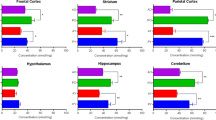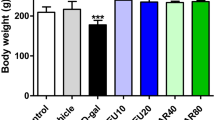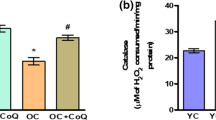Abstract
A combination of antioxidants (N-acetyl cysteine, α-lipoic acid, and α-tocopherol) was selected for long term oral supplementation study in rats for protective effects on age-related mitochondrial alterations in the brain. Four groups of rats were chosen: young control (6–7 months); aged rats (22–24 months); aged rats (22–24 months) on daily antioxidant supplementation from 18 month onwards and young rats (6–7 months) on daily antioxidant supplementation from 2 month onwards. The brain mitochondrial functional parameters, status of antioxidant enzymes and accumulation of oxidative damage markers were measured in the four groups of rats. A significant decrease in complex IV activity and a loss of transmembrane potential and phosphorylation capacity along with an increased accumulation of oxidative damage markers and compromised antioxidant enzyme status were noticed in aged rat brain mitochondria as compared to that in young controls, but in aged rats supplemented with oral antioxidants the mitochondrial alterations were largely prevented. Antioxidant supplementation in young rats had no effect on mitochondrial parameters investigated in this study. The results have implications in biochemical and functional deficits of brain during aging as well as in neurodegenerative disorders.





Similar content being viewed by others
References
Aebi H (1984) Catalase in vitro. Methods Enzymol 105:121–126
Albers DS, Beal MF (2000) Mitochondrial dysfunction and oxidative stress in aging and neurodegenerative disease. J Neural Transm Suppl 59:133–154
Allen RG, Tresini M (2000) Oxidative stress and gene regulation. Free Radic Biol Med 28:463–499
Bagh MB, Maiti AK, Roy A, Chakrabarti S (2008) Dietary supplementation with N-acetylcysteine, α-tocopherol and α-lipoic acid prevents age related decline in Na+, K+-ATPase activity and associated peroxidative damage in rat brain synaptosomes. Biogerontol 9:421–428
Banerjee K, Sinha M, Pham CLL, Jana S, Chanda D, Cappai R, Chakrabarti S (2010) α-Synuclein induced membrane depolarization and loss of phosphorylation capacity of isolated rat brain mitochondria: Implications in Parkinson’s disease. FEBS Lett 584:1571–1576
Barja G (2004) Free radicals and aging. Trends Neurosci 27:595–600
Berman SB, Hastings TG (1999) Dopamine oxidation alters mitochondrial respiration and induces permeability transition in brain mitochondria: implications for Parkinson’s disease. J Neurochem 73:1127–1137
Bishop NA, Lu T, Yankner BA (2010) Neural mechanisms of ageing and cognitive decline. Nature 464:529–535
Bjelakovic G, Nikolova D, Gluud LL, Simonetti RG, Gluud C (2007) Systematic review and meta-analysis supplements for primary and secondary prevention: mortality in randomized trials of antioxidant. JAMA 297:842–857
Boveris A, Navarro A (2008) Brain mitochondrial dysfunction in aging. IUBMB life 60:308–314
Bowling AC, Mutisya EM, Walker LC, Price DL, Cork LC, Beal MF (1993) Age-dependent impairment of mitochondrial function in primate brain. J Neurochem 60:1964–1967
Brookes PS, Yoon Y, Robotham JL, Anders MW, Sheu SS (2004) Calcium, ATP, and ROS: a mitochondrial love-hate triangle. Am J Physiol Cell Physiol 287:C817–C833
Cao Z, Tsang M, Zhao H, Li Y (2003) Induction of endogenous antioxidants and phase II enzymes by alpha lipoic acid in rat cardiac H9C2 cells: protection against oxidative injury. Biochem Biophys Res Commun 310:979–985
Chakraborty H, Sen P, Sur A, Chatterjee U, Chakrabarti S (2003) Age-related oxidative inactivation of Na+, K+-ATPase in rat brain crude synaptosomes. Exp Gerontol 38:705–710
Clark JB, Bates TE, Boakye P, Kuimov A, Land JM (1997) Investigation of mitochondrial defects in brain and skeletal muscle in Neurochemistry: a practical approach. Oxford University Press Inc, New York
Cocco T, Sgobbo P, Clemente M, Lopriore B, Grattagliano I, Di Paola M, Villani G (2005) Tissue-specific changes of mitochondrial functions in aged rats: effect of a long-term dietary treatment with N acetylcysteine. Free Radic Biol Med 38:796–805
Cotman CW, Head E, Muggenburg BA, Zicker S, Milgram NW (2002) Brain aging in the canine: a diet enriched in antioxidants reduces cognitive dysfunction. Neurobiol Aging 23:809–818
Crouch PJ, Cimdins K, Duce JA, Bush AI, Trounce IA (2007) Mitochondria in aging and Alzheimer’s disease. Rejuvenation Res 3:349–357
Echtay KS, Esteves TC, Pakay JL, Jekabsons MB, Lambert AJ, Portero-Otín M, Pamplona R, Vidal-Puig AJ, Wang S, Roebuck SJ, Brand MD (2003) A signalling role for 4-hydroxy-2-nonenal in regulation of mitochondrial uncoupling. EMBO J 22:4103–4110
Eckert A, Keil U, Scherping I, Hauptmann S, Müller WE (2005) Stabilization of mitochondrial membrane potential and improvement of neuronal energy metabolism by Ginkgo Biloba extract EGb 761. Ann N Y Acad Sci 1056:474–485
Farr SA, Poon HF, Dogrukol-Ak D, Drake J, Banks WA, Eyerman E, Butterfield DA, Morley JE (2003) The antioxidants alpha-lipoic acid and N-acetylcysteine reverse memory impairment and brain oxidative stress in aged SAMP8 mice. J Neurochem 84:1173–1183
Ferrandiz ML, Martinez M, De Juan E, Diez A, Bustos G, Miquel J (1994) Impairment of mitochondrial oxidative phosphorylation in the brain of aged mice. Brain Res 644:335–338
Ghibu S, Richard C, Delemasure S, Vergely C, Mogosan C, Muresan A (2008) An endogenous dithiol with antioxidant properties: alpha-lipoic acid, potential uses in cardiovascular diseases. Ann Cardiol Angeiol 57:161–165
Gius D, Botero A, Shah S, Curry HA (1999) Intracellular oxidation/reduction status in the regulation of transcription factors NF-kappaB and AP-1. Toxicol Lett 106:93–106
Hagen TN, Ingersoll RT, Lykkesfeldt J, Liu J, Wehr CM, Vinarsky V, Bartholomew JC, Ames BN (1999) R-α Lipoic acid supplemented old rats have improved mitochondrial function, decreased oxidative damage, and increased metabolic rate. FASEB J 13:411–418
Halestrap AP, Woodfield KY, Connern CP (1997) Oxidative stress, thiol reagents, and membrane potential modulate the mitochondrial permeability transition by affecting nucleotide binding to the adenine nucleotide translocase. J Biol Chem 272:3346–3354
Halliwell B, Gutteridge JMC (1999) Free radicals in biology and medicine, third ed. Oxford University Press, New York
Harvey BH, Joubert C, du Preez JL, Berk M (2008) Effect of chronic N-acetyl cysteine administration on oxidative status in the presence and absence of induced oxidative stress in rat striatum. Neurochem Res 33:508–517
Head E (2007) Combining an antioxidant-fortified diet with behavioural enrichment leads to cognitive improvement and reduced brain pathology in aging canines: strategies for healthy aging. Ann N YAcad Sci 1114:398–406
Hinkle PC (1995) Oxygen proton and phosphate fluxes and stoichiometries. In: Brown GC, Cooper CE (eds) Bioenergetics: a practical approach. Oxford IRL Press, pp 1–16
Jana S, Maiti AK, Bagh MB, Banerjee K, Das A, Roy A, Chakrabarti S (2007) Dopamine but not 3, 4 dihydroxy phenylacetic acid (DOPAC) inhibits brain respiratory chain activity by auto-oxidation and mitochondria catalyzed oxidation to quinone products: Implication in Parkinson’s disease. Brain Res 1139:195–200
Kantrow SP, Tatro LG, Piantadosi CA (2000) Oxidative stress and adenine nucleotide control of mitochondrial permeability transition. Free Radic Biol Med 28:251–260
Katsuoka F, Motohashi H, Ishii T, Aburatani H, Engel JD, Yamamoto M (2005) Genetic evidence that small maf proteins are essential for the activation of antioxidant response element-dependent genes. Mol Cell Biol 25:8044–8051
Khan FH, Sen T, Maiti AK, Jana S, Chatterjee U, Chakrabarti S (2005) Inhibition of rat brain mitochondrial electron transport chain activity by dopamine oxidation products during extended in vitro incubation: implications for Parkinson’s disease. Biochim Biophys Acta 1741:65–74
Kwong LK, Sohal RS (2000) Age-related changes in activities of mitochondrial electron transport complexes in various tissues of the mouse. Arch Biochem Biophys 373:16–22
Laemmli UK (1970) Cleavage of structural proteins during the assembly of the head of bacteriophage T4. Nature 227:680–685
Lee HC, Wei YH (2007) Oxidative stress, mitochondrial DNA mutation, and apoptosis in aging. Exp Biol Med 232:592–606
Lee JM, Li J, Johnson DA, Stein TD, Kraft AD, Calkins MJ, Jakel RJ, Jeffrey A, Johnson JA (2005) Nrf2, a multi-organ protector? FASEB J 219:1061–1066
Leonard SS, Harris GK, Shi X (2004) Metal-induced oxidative stress and signal transduction. Free Radic Biol Med 37:1921–1942
Levine RL, Williams JA, Stadtman ER, Shacter E (1994) Carbonyl assays for determination of oxidatively modified proteins. Methods Enzymol 233:346–357
Lin MT, Beal MF (2006) Mitochondrial dysfunction and oxidative stress in neurodegenerative diseases. Nature 443:787–795
Lindsay J, Laurin D, Verreault R, Hébert R, Helliwell B, Hill GB, McDowell I (2002) Risk factors for Alzheimer’s disease: a prospective analysis from the Canadian study of health and aging. Am J Epidemiol 156:445–453
Liu J (2008) The effects and mechanisms of mitochondrial nutrient α-lipoic acid on improving age associated mitochondrial and cognitive dysfunction: an overview. Neurochem Res 33:194–203
Liu J, Head E, Gharib AM, Yuan W, Ingersoll RT, Hagen TM, Cotman CW, Ames BN (2002a) Memory loss in old rats is associated with brain mitochondrial decay and RNA/DNA oxidation: partial reversal by feeding acetyl-L-carnitine and/or R-α- lipoic acid. Proc Natl Acad Sci 99:2356–2361
Liu J, Killilea DW, Ames BN (2002b) Age-associated mitochondrial oxidative decay: improvement of carnitine acetyltransferase substrate-binding affinity and activity in brain by feeding old rats acetyl-L- carnitine and/or R-alpha -lipoic acid. Proc Natl Acad Sci 99:1876–1881
Loerch PM, Lu T, Dakin KA, Vann JM, Isaacs A, Geula C, Wang J, Pan Y, Gabuzada DH, Li C, Prolla TA, Yankner BA (2008) Evolution of the aging brain transcriptome and synaptic regulation. PLoS One 3:e3329
Long J, Gao F, Tong L, Cotman CW, Ames BN, Liu J (2009) Mitochondrial decay in the brains of old rats: ameliorating effect of alpha-lipoic acid and acetyl-L-carnitine. Neurochem Res 34:755–763
Lowry OH, Rosebrough NJ, Farr AL, Randall RJ (1951) Protein measurement with the Folin–Phenol reagent. J Biol Chem 193:265–275
Lu T, Pan Y, Kao SY, Li C, Kohane I, Chan J, Yankner BA (2004) Gene regulation and DNA damage in the ageing human brain. Nature 429:883–891
Mancuso M, Coppede F, Migliore L, Siciliano G, Murri L (2006) Mitochondrial dysfunction, oxidative stress and neurodegeneration. J Alzheimers Dis 10:59–73
Manczaak M, Jung Y, Park BS, Partovi D, Reddy PH (2005) Time course of mitochondrial gene expression in mice brains implications for mitochondrial dysfunction, oxidative damage and cytochrome C in aging. J Neurochem 92:494–504
Mather M, Rottenberg H (2000) Aging enhances the activation of the permeability transition pore in mitochondria. Biochem Biophys Res Commun 273:603–608
Matsuyama S, Llopis J, Deveraux QL, Tsien RY, Reed JC (2000) Changes in intramitochondrial and cytosolic pH: early events that modulate caspase activation during apoptosis. Nat Cell Biol 2:318–325
Milgram NW, Araujo JA, Hagen TM, Treadwell BV, Ames BN (2007) Acetyl L carnitine and alpha lipoic acid supplementation of aged beagle dogs improves learning in two landmark discrimination tests. Faseb J 21:3756–3762
Misra HP, Fridovich I (1972) The Role of Superoxide Anion in the Autoxidation of Epinephrine and a Simple Assay for Superoxide Dismutase. J Biol Chem 247:3170–3175
Murray J, Teller SW, Zhang B, Ghosh SS, Capaldi RA (2003) Oxidative damage to mitochondrial complex I due to peroxynitrite: Identification of reactive tyrosines by mass spectrometry. J Biol Chem 278:37223–37330
Navarro A (2004) Mitochondrial enzyme activity as biochemical markers of aging. Mol Aspects Med 25:37–48
Navarro A, Boveris A (2004) Rat brain and liver mitochondria develop oxidative stress and loose enzymatic activity with aging. Am J Physiol Regul Integr Comp Physiol 287:R1244–R1249
Navarro A, Gòmez C, Sánchez-Pino MJ, González H, Bández MJ, Boveris AD, Boveris A (2005) Vitamin E at high doses improves survival, neurological performance and brain mitochondrial function in aging male mice. Am J Physiol Regul Integr Comp Physiol 289:R1392–R1399
Nicoletti VG, Marino VM, Cuppari C, Licciardello D, Patti D, Purrello V, Stella AM (2005) Effect of antioxidant diets on mitochondrial gene expression in rat brain during aging. Neurochem Res 30:737–752
Ojaimi J, Masters CL, Opeskin K, Mckelvie P, Byrne E (1999) Mitochondrial respiratory chain activity in the human brain as a function of age. Mech Ageing Dev 111:39–47
Paradies G, Petrosillo G, Pistolese M, Ruggiero FM (2000) The effect of reactive oxygen species generated from the mitochondrial electron transport chain on the cytochrome c oxidase activity and on the cardiolipin content in bovine heart submitochondrial particles. FEBS Lett 466:323–326
Paradies G, Petrosillo G, Pistolese M, Ruggiero FM (2002) Reactive oxygen species affect mitochondrial electron transport complex I activity through oxidative cardiolipin damage. Gene 286:135–141
Petrosillo G, Ruggiero FM, Pistolese M, Paradies G (2004) Ca2+ induced reactive oxygen species production promotes cytochrome c release from rat liver mitochondria via mitochondrial permeability transition (MPT)-dependent and MPT-independent mechanisms: role of cardiolipin. J Biol Chem 279:53103–53108
Petrosillo G, Matera M, Casanova G, Ruggiero FM, Paradies G (2008) Mitochondrial dysfunction in rat brain with aging. Involvement of complex I, reactive oxygen species and cardiolipin. Neurochem Int 53:126–131
Pitlik TN, Bulai PM, Denisov AA, Afanasenkov DS, Cherenkevich SN (2009) Redox regulation of ionic homeostasis in neurons. Neurochem J 3:87–92
Poon HF, Calabrese V, Scapagnini G, Butterfield DA (2004) Free radicals: key to brain aging and heme oxygenase as a cellular response to oxidative stress. J Gerontol A Biol Sci Med Sci 59:478–493
Rego AC, Oliveira CR (2003) Mitochondrial dysfunction and reactive oxygen species in excitotoxicity and apoptosis: implications for the pathogenesis of neurodegenerative diseases. Neurochem Res 28:1563–1574
Ristow M, Zarse K, Oberbach A, Klöting N, Birringer M, Kiehntopf M, Stumvoll M, Kahn CR, Blüher M (2009) Antioxidants prevent health-promoting effects of physical exercise in humans. Proc Natl Acad Sci 106:8665–8670
Sastre J, Pallardo FV, Garcia de la Assuncion J, Vina J (2000) Mitochondria, oxidative stress and aging. Free Radic Res 32:189–198
Sen CK, Packer L (1996) Antioxidant and redox regulation of gene transcription. FASEB J 10:709–720
Sen T, Sen N, Tripathi G, Chatterjee U, Chakrabarti S (2006) Lipid peroxidation associated cardiolipin loss and membrane depolarization in rat brain mitochondria. Neurochem Int 49:20–27
Sen T, Sen N, Jana S, Khan FH, Chatterjee U, Chakrabarti S (2007) Depolarization and cardiolipin depletion in aged rat brain mitochondria: Relationship with oxidative stress and electron transport chain activity. Neurochem Int 50:719–725
Shay KP, Moreau RF, Smith EJ, Smith AR, Hagen TM (2009) Alpha-lipoic acid as a dietary supplement: molecular mechanisms and therapeutic potential. Biochim Biophys Acta 1790:1149–1160
Shigenaga MK, Hagen TM, Ames BN (1994) Oxidative damage and mitochondrial decay in aging. Proc Natl Acad Sci 91:10771–10778
Shimasaki H (1994) Assay of fluorescent lipid peroxidation products. Methods Enzymol 233:338–346
Sinha M, Saha A, Basu S, Pal K, Chakrabarti S (2010) Aging and antioxidants modulate rat brain levels of homocysteine and dehydroepiandrosterone sulphate (DHEA-S): implications in the pathogenesis of Alzheimer’s disease. Neurosci Lett 483:123–126
Sun M, Zigman S (1978) An improved spectrophotometric assay for superoxide dismutase based on epinephrine autoxidation. Anal Biochem 90:81–89
Turner C, Schapira AH (2001) Mitochondrial dysfunction in neurodegenerative disorders and ageing. Adv Exp Med Biol 487:229–251
Versari D, Daghini E, Rodriguez-Porcel M, Sattler K, Galili O, Pilarczyk K, Napoli C, Lerman LO, Lerman A (2006) Chronic antioxidant supplementation impairs coronary endothelial function and myocardial perfusion in normal pigs. Hypertension 47:475–481
Wendel A (1980) Glutathione peroxidase. In: Jakoby W (ed) Enzymatic Basis of Detoxification. Academic Press, New York, pp 333–353
Wharton DC, Tzagoloff A (1967) Cytochrome oxidase from beef heart mitochondria. Methods Enzymol 10:245–250
Zafarullah M, Li WQ, Sylvester J, Ahmad M (2003) Molecular mechanisms of N-acetylcysteine actions. Cell Mol Life Sci 60:6–20
Zhang Y, Marcillat O, Giulivi C, Ernster L, Davies KJ (1990) The oxidative inactivation of mitochondrial electron transport chain components and ATPase. J Biol Chem 265:16330–16336
Acknowledgment
This study was supported by a grant from Indian Council of Medical Research (ICMR), Govt. of India. (48/12/2006-TF/Aging brain/BMS).
Author information
Authors and Affiliations
Corresponding author
Electronic supplementary material
Below is the link to the electronic supplementary material.
Rights and permissions
About this article
Cite this article
Bagh, M.B., Thakurta, I.G., Biswas, M. et al. Age-related oxidative decline of mitochondrial functions in rat brain is prevented by long term oral antioxidant supplementation. Biogerontology 12, 119–131 (2011). https://doi.org/10.1007/s10522-010-9301-8
Received:
Accepted:
Published:
Issue Date:
DOI: https://doi.org/10.1007/s10522-010-9301-8




